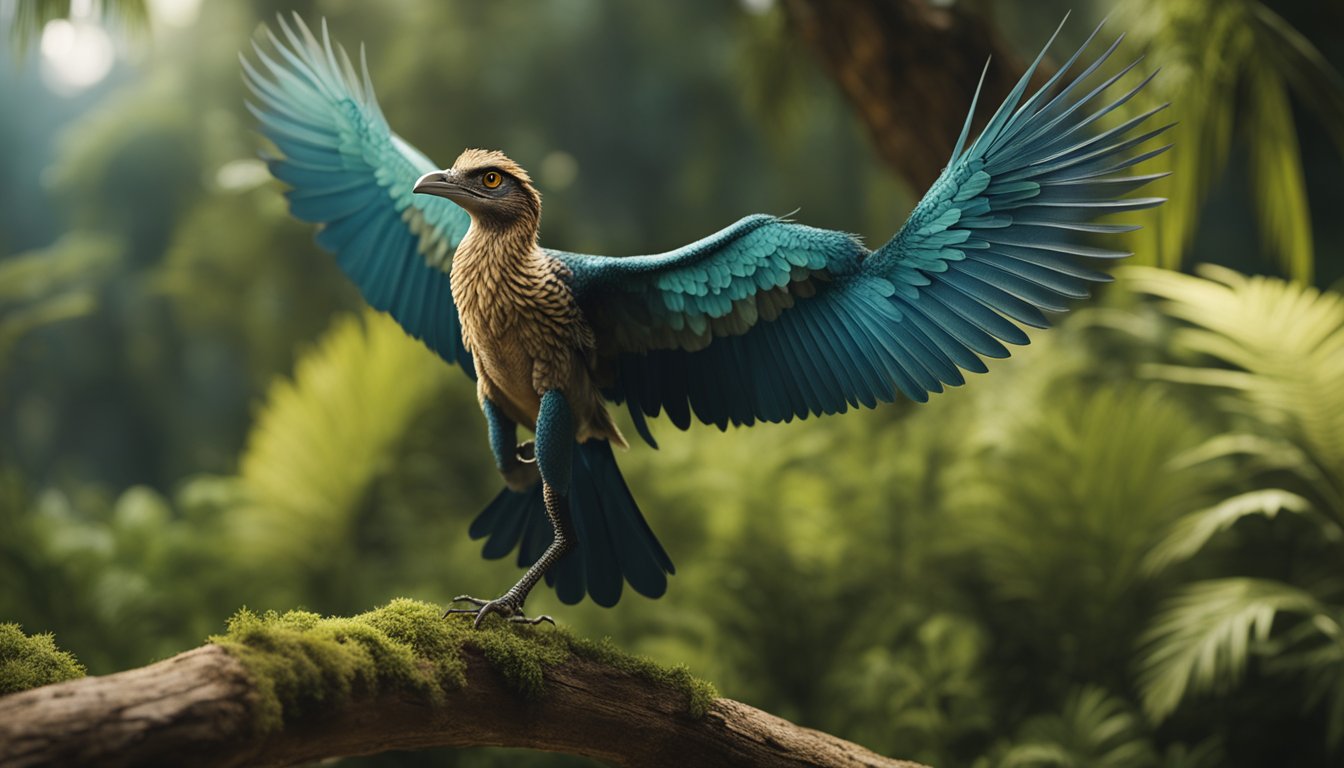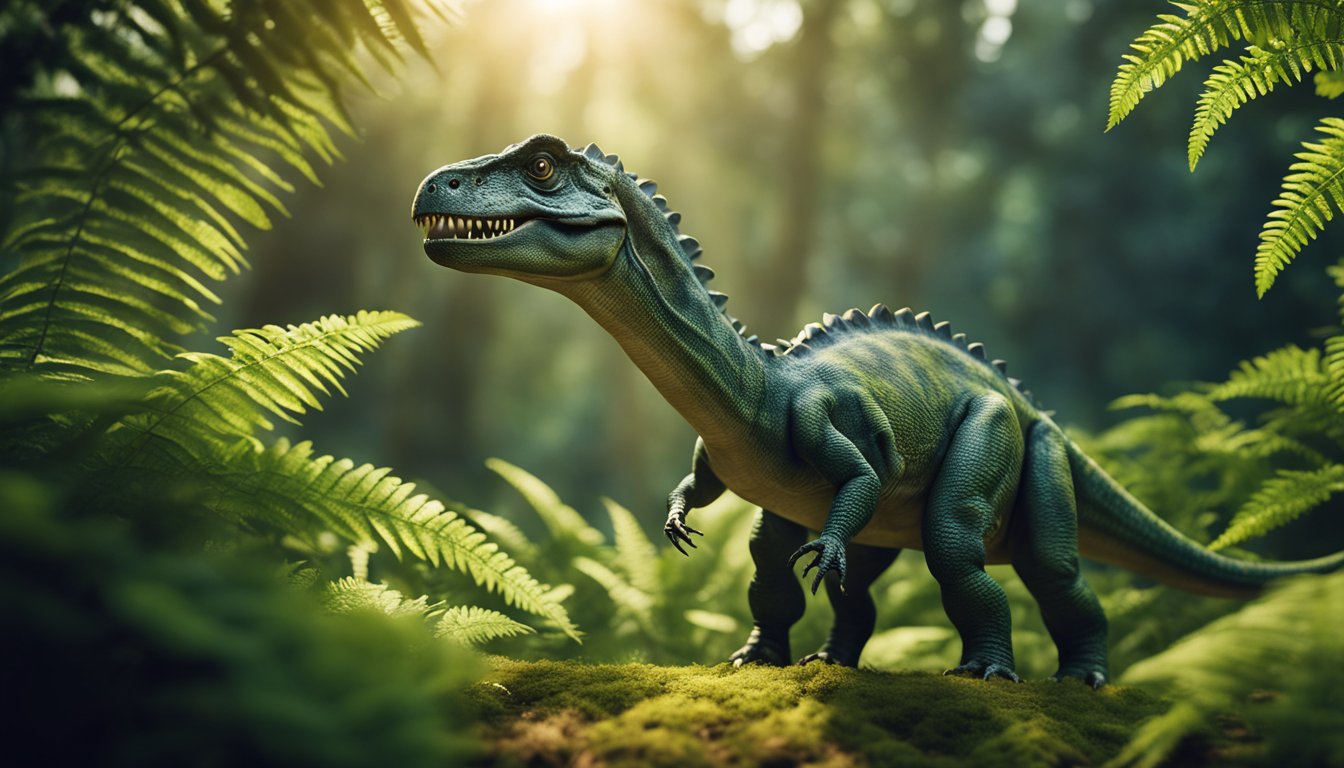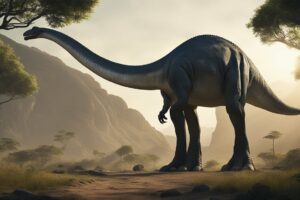Archaeopteryx is a fascinating creature that holds a special place in the history of evolution.
It is widely considered to be the first bird, and yet it has many features that are more closely associated with dinosaurs.
The fossils of Archaeopteryx have been found in Germany, specifically in the limestone quarries of Solnhofen, and date back to the Late Jurassic Period, around 150 million years ago.

The discovery of Archaeopteryx had a significant impact on the scientific community and helped shape the theory of evolution.
Charles Darwin himself referenced Archaeopteryx in his book, “On the Origin of Species,” as evidence of the evolutionary link between birds and reptiles.
The fossils of Archaeopteryx were so well-preserved that scientists were able to identify feather impressions, which further supported the idea that birds evolved from dinosaurs.
Despite its bird-like characteristics, Archaeopteryx also had many features that were more commonly associated with dinosaurs, such as sharp teeth and a long bony tail.
Unraveling the Mystery of Archaeopteryx
Archaeopteryx, the first bird, has puzzled scientists for over a century.
Its discovery in the Solnhofen limestone quarries of Germany in 1861 caused a sensation in the scientific community.
Since then, numerous fossils have been found, revealing new insights into the evolution of birds and dinosaurs.
Fascinating Fossils from Solnhofen
The Solnhofen limestone quarries are famous for their well-preserved fossils.
The fine-grained limestone has preserved not only the bones but also the soft tissues of ancient animals.
The fossils from Solnhofen have provided scientists with a unique window into the past, revealing the diversity of life during the Jurassic period.
One of the most remarkable fossils found in Solnhofen is Archaeopteryx.
The fossilized remains of this ancient bird have been studied extensively, providing valuable insights into the evolution of flight and the link between birds and dinosaurs.
The Tale of Feathers and Flight
One of the most intriguing aspects of Archaeopteryx is its feathers.
The fossilized feathers show clear evidence of flight capabilities, but the question remains: did Archaeopteryx fly or glide?
Some scientists believe that Archaeopteryx was capable of powered flight, while others think it was only capable of gliding.
Recent studies have shown that Archaeopteryx had a combination of features that suggest it was capable of powered flight, such as asymmetrical flight feathers and a keeled sternum.
Despite the ongoing debate about the flight capabilities of Archaeopteryx, there is no doubt that this ancient bird played a crucial role in the evolution of flight.
Its feathers and wings provided a template for the evolution of flight in modern birds.
In conclusion, Archaeopteryx is a fascinating creature that has captured the imagination of scientists and the public alike.
Its fossils have provided valuable insights into the evolution of birds and dinosaurs, and its feathers have shed light on the origins of flight.
As scientists continue to study this ancient bird, we can expect to learn even more about the evolution of life on Earth.
Archaeopteryx and the Dinosaur Connection

Archaeopteryx is a fascinating creature that has puzzled scientists for years.
It is often referred to as the first bird, but it also has many characteristics of dinosaurs.
In this section, we will explore the connection between Archaeopteryx and dinosaurs.
A Link Between Birds and Dinosaurs
Archaeopteryx is considered a transitional species between dinosaurs and birds. It lived during the Late Jurassic Period, about 150 million years ago.
At that time, the world was dominated by reptilian creatures, with dinosaurs being the most prevalent.
The discovery of Archaeopteryx fossils in Germany in 1861 caused a lot of confusion. No birds were known from so far back.
Some people even thought it might be an angel.
However, the fossilized bones, claws, teeth, and bony tail of Archaeopteryx clearly indicate that it was a reptilian creature.
The most significant discovery was the presence of feathers on Archaeopteryx fossils.
This finding provided evidence of a close relationship between dinosaurs and birds.
Today, scientists believe that birds evolved from a group of feathered dinosaurs called theropods.
Traits Shared with Theropods
Archaeopteryx had many features that are similar to theropod dinosaurs.
For example, it had a wishbone, which is a unique feature of birds and some dinosaurs. It also had a breastbone that was similar to those of theropods.
The bones in its wings were asymmetrical, which is a trait shared with theropods.
Another characteristic of theropods that Archaeopteryx shared was its sharp claws.
The claws on its wings were used for gripping and climbing, while the claws on its feet were used for grasping prey.
However, Archaeopteryx was not a strong flyer. It probably took short, low-level flights, like today’s partridges.
In conclusion, Archaeopteryx was a unique creature that had both bird-like and reptilian characteristics.
Its discovery has helped scientists understand the connection between dinosaurs and birds.
By studying its bones, claws, teeth, bony tail, wishbone, and breastbone, scientists have been able to piece together the evolutionary history of birds.
The Evolutionary Significance of Archaeopteryx

Archaeopteryx is a fascinating ancient creature that has captured the attention of scientists and the public alike for over a century.
It is widely considered the earliest bird, but its unique combination of bird and dinosaur features has also made it a crucial transitional fossil in our understanding of avian evolution.
From Gliding to Active Flight
One of the most significant aspects of Archaeopteryx is its ability to glide.
This feature is believed to have been an adaptation that allowed it to escape predators or travel between trees.
However, it is also a crucial step in the evolution of active flight.
The wings of Archaeopteryx are not as well-developed as those of modern birds, but they show clear signs of being used for flapping flight.
This suggests that Archaeopteryx was on the cusp of evolving into a fully-fledged bird capable of powered flight.
The Role in Understanding Avian Evolution
The discovery of Archaeopteryx was a pivotal moment in the history of evolutionary biology.
It provided a clear link between birds and their dinosaur ancestors, supporting the theory of evolution and Charles Darwin’s ideas on the origin of species.
Today, we know that birds are a type of dinosaur, and Archaeopteryx is a crucial piece of evidence that supports this idea.
Moreover, Archaeopteryx has also played a vital role in our understanding of avian evolution.
Its unique combination of bird and dinosaur features has allowed scientists to trace the evolution of modern birds back to their ancient ancestors.
By studying the skeletal structure of Archaeopteryx and comparing it to that of living birds, scientists have been able to reconstruct the evolutionary history of avialae, the group that includes all living birds.
In conclusion, Archaeopteryx is an essential figure in the study of evolutionary biology and avian evolution.
Its unique features have allowed scientists to trace the evolution of birds back to their dinosaur ancestors and understand the transition from gliding to active flight.
By studying this ancient creature, we can learn more about the natural world and the complex processes that have shaped it over millions of years.
The Legacy of Archaeopteryx in Modern Science

Archaeopteryx, the first bird, has played a significant role in shaping our understanding of the evolution of birds and their connection to dinosaurs.
This prehistoric creature has inspired countless paleontologists and scientists to explore the mysteries of the past and uncover the secrets of the natural world.
Inspirations in Paleontology and Beyond
The discovery of the Berlin specimen of Archaeopteryx in 1877 by Hermann von Meyer, and the subsequent discovery of the London specimen in 1861, revolutionized the field of paleontology.
These fossils provided the first concrete evidence of the evolutionary link between birds and dinosaurs, and sparked a renewed interest in the study of prehistoric creatures.
Since then, numerous other specimens of Archaeopteryx have been discovered, each providing valuable insights into the evolution of birds.
For example, the latest study published in Nature Communications in 2020 analyzed the wing bones of Archaeopteryx to reveal that it was capable of flapping flight, similar to modern birds.
Archaeopteryx has also inspired scientists in other fields beyond paleontology.
For instance, its feathers have served as a model for designing advanced materials for aerospace and other industries.
Archaeopteryx in Popular Culture
Archaeopteryx has captured the imagination of people around the world and has become a popular icon in popular culture.
Its unique combination of bird and dinosaur features has made it a fascinating subject for artists, writers, and filmmakers.
For example, the American Museum of Natural History featured an exhibit on Archaeopteryx that showcased the latest research and discoveries about this prehistoric creature.
In addition, the Urvogel, a life-size model of Archaeopteryx, has become a popular attraction at the Museum für Naturkunde in Berlin.
Archaeopteryx has also appeared in numerous movies, TV shows, and video games, cementing its place in popular culture.
Its legacy continues to inspire people of all ages to explore the wonders of the natural world and to learn more about the fascinating creatures that roamed the earth millions of years ago.
Frequently Asked Questions

What features make Archaeopteryx a significant link between dinosaurs and modern birds?
Archaeopteryx is considered a significant link between dinosaurs and modern birds due to its unique combination of characteristics.
It has bird-like features such as feathers, wings, and a wishbone, as well as dinosaur-like features such as teeth, a long bony tail, and a body covered in scales.
These features suggest that Archaeopteryx was a transitional species, sharing traits with both dinosaurs and modern birds.
How did the discovery of Archaeopteryx change our understanding of bird evolution?
The discovery of Archaeopteryx in 1861 challenged the prevailing view at the time that birds evolved from mammals.
Instead, it provided evidence that birds evolved from a group of small, feathered dinosaurs called theropods.
This discovery revolutionized our understanding of bird evolution and helped establish the field of evolutionary biology.
Can you explain the similarities and differences between Archaeopteryx and its dinosaur relatives?
Archaeopteryx shares many similarities with its dinosaur relatives, such as having a long, bony tail and sharp teeth.
However, it also has several unique features that distinguish it from other dinosaurs, such as feathers, wings, and a wishbone.
These features suggest that Archaeopteryx was a transitional species between non-avian dinosaurs and modern birds.
What does the fossil evidence suggest about the lifestyle and habitat of Archaeopteryx?
Based on fossil evidence, scientists believe that Archaeopteryx lived in a forested environment and likely ate insects, small vertebrates, and possibly even fruit.
Its feathers suggest that it was capable of flight, although it may not have been a strong or sustained flier.
In what ways did Archaeopteryx adapt for flight compared to its non-avian dinosaur counterparts?
Archaeopteryx adapted for flight in several ways, including the development of feathers, wings, and a wishbone.
Its feathers likely provided insulation and improved aerodynamics, while its wings allowed for powered flight.
The wishbone, a feature unique to birds, helped to anchor the powerful muscles used in flight.
Why is the Archaeopteryx fossil considered a key piece of evidence in the dinosaur-bird transition?
The Archaeopteryx fossil is considered a key piece of evidence in the dinosaur-bird transition because it provides a clear link between non-avian dinosaurs and modern birds.
Its unique combination of bird-like and dinosaur-like features suggests that it was a transitional species, sharing traits with both groups.
The discovery of Archaeopteryx helped to establish the idea that birds evolved from dinosaurs, a theory that is widely accepted today.






